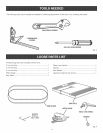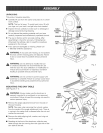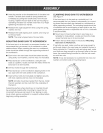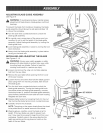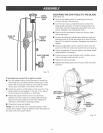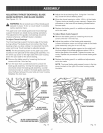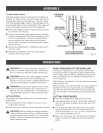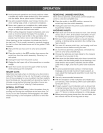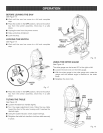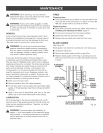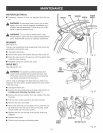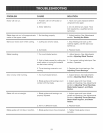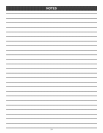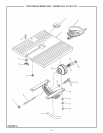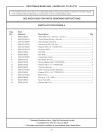
[] Avoidawkwardoperationsandhandpositionswhere
asuddenslipcouldcauseseriousinjuryfromcontact
withtheblade.Neverplacehandsinbladepath.
[] Useextrasupports(tables,sawhorses,blocks,etc.)
whencuttinglarge,small,orawkwardworkpieces.
[] Neverusea personasasubstituteforatableexten-
sionorasadditionalsupportforaworkpiecethatis
longerorwiderthanthebasicsawtable.
[] Whencuttingirregularlyshapedworkpieces,planyour
worksoit willnotpinchtheblade.Forexample,a
pieceofmoldingmustlieflatonthesawtable.Work-
piecesmustnottwist,rockorslipwhilebeingcut.
Whenbackinguptheworkpiece,theblademaybindin
thekerf(cut).Thisisusuallycausedbysawdustclogging
thekerforwhenthebladecomesoutoftheguides.Hfthis
happens:
[] Waituntilthesawhascometo afullandcomplete
stop.
[] PlacetheswitchintheOFFpositionthenremovethe
switchkeyfromtheswitchassembly,.Storekeyina
safeplace.
[] Unplugthesawfromthepowersource.
[] Wedgethekerfopenwithafiatscrewdriverorwooden
wedge.
[] Openfrontcoverandturntheupperwheelbyhand
whilebackinguptheworkpiece.
RELmEF CUTS
Relief cuts are made when an intricate curve (too small a
radius for the blade) is to be cut. Cut through a scrap sec-
tion of the workpiece to curve in pattern line then carefully
back the blade out. Several relief cuts should be made for
intricate curves before following the pattern line as sec-
tions are cutoff of curve "relieving" blade pressure.
SCROLL CUTTmNG
For general type scroll cutting, follow the pattern lines by
pushing and turning the workpiece at the same time. Do
not try to turn the workpiece while engaged in the blade
without pushing it, the workpiece could bind or twist the
blade.
REMOVING JAMMED MATERIAL
Never remove jammed cutoff pieces until the blade has
come to a full and complete stop.
[] Place the switch in the OFF position, remove the
switch key from the switch assembly.
[] Unplug the saw from the power source before remov-
ing jammed material.
AVOmDmNG mNJURY
[] Make sure saw is level and does not rock. Saw should
always be on a firm, leve! surface with plenty of room
for handling and properly supporting the workpiece.
[] Bolt saw to the support surface to prevent slipping,
walking, or sliding during operations like cutting long,
heavy boards.
[] Turn saw off, remove switch key, and unplug cord from
the power source before moving the saw.
[] Do not remove jammed cutoff pieces until blade has
come to a full and complete stop.
[] Choose the right size and style blade for the material
and type of cut you plan to do.
[] Make sure that the blade teeth point down toward the
saw table, that the blade guides, thrust bearings, and
blade tension are properly adjusted, that the blade
guide knob is tight, and that no parts have excessive
play.
[] To avoid accidental blade contact, minimize blade
breakage, and provide maximum blade support, al-
ways adjust the blade guide assembly to just clear the
workpiece.
[] Use only recommended accessories.
[] With the exception of the workpiece and related sup-
port devises, clear everything off the saw table before
turning the saw on.
[] Properly support round materials such as dowel rods
or tubing because they have a tendency to roll during
a cut causing the blade to "bite." To avoid this, always
use a "V" block or clamp workpiece to a miter gauge.
[] Before removing loose pieces from the saw table, turn
saw off and wait for all moving parts to stop.
19



